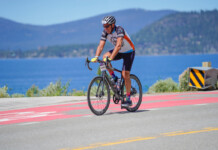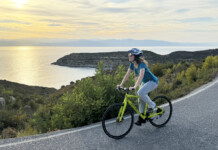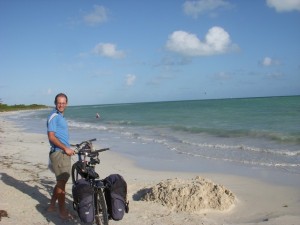
By Martin Cuma
What to do with frequent flyer miles when they are about to expire? That’s the dilemma that my wife Shelly and I we were facing last spring. The consensus was to go as far south as possible within the continental US when the weather turns cold. Thus we ended up with two tickets to Miami flying out on Thanksgiving Day in the morning and coming back on Friday the following week. The idea was to get some beach time on the Florida Keys, I figured we’d rent a car like every normal couple would do and explore the Keys from behind the windshield. However, in late summer, as the time of departure came closer, I found out about the existence of the Florida Keys Overseas Heritage Trail (FKOHT) (http://www.dep.state.fl.us/gwt/state/keystrail/default.htm), which runs along the Keys from northernmost Key Largo to southernmost Key West. Thus an idea was born to take our tandem along and ride the Keys on two instead of four wheels.
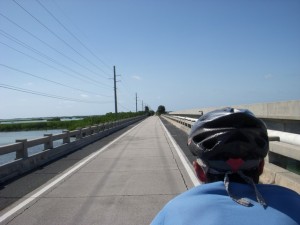
We have an S&S (sandsmachine.com) coupled tandem which makes air travel easier since the tandem and accessories fit into two suitcases that can move through the airport unrecognized by the ticket agents and avoid the multi-hundred dollar fees that airlines charge these days for flying a bike. I was bending over to spend the extra $1200 on the S&S option years back, but in retrospect it was one of the best investments I have ever made. As our tours are usually a short vacation away from our busy lives, we tend to stay at hotels and eat out, which makes packing relatively easy, we can fit and carry all our stuff on the rear rack of the tandem. The places we stayed during the week in the Keys ranged from resort like to budget motels depending on what we could find along the way, for the more budget minded there are also several state parks dispersed along the way that offer camping and beach in one package.
The FKOHT website provides excellent information about the trail status. While the trail is still a work in progress, the plan is to have a continuous non-motorized trail running the whole length of the Keys, utilizing the historic bridges built originally for a railroad, then repurposed for a highway after the railroad was destroyed by a hurricane in 1935, and now abandoned as the new, much wider highway bridges have been built. A quick look at the map from the website may make one think that the trail is mostly finished, the reality is far from it. There are numerous gaps, plus most of the trail in the urban environment (Islamorada, Marathon) is sub-standard with narrow path and barely marked driveway and business crossings. Motorists not aware of the trail existence tend to stop right on the trail waiting for a break in the busy traffic on US-1 highway, effectively rendering the trail unusable. Oftentimes, it is safer and more convenient to stay on the parallel US-1 highway, which has a reasonable shoulder most of the time.
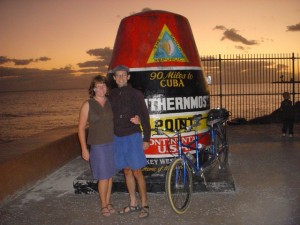
There are also some beautiful trail sections on the rehabilitated historic bridges and on a few islands, where the trail has been done recently and the profile is wider (10-12 ft). Beach opportunities are somewhat scarce since the environment is mangrove swamps, but, in the middle and lower Keys (from ca. mile 80 down), there is something every 5 miles or so. So, taking it easy and stopping for a swim is definitely a good idea. Overall, for a seasoned biker without small kids, the whole trip is fairly good, at least for the US standards. I am looking forward to the progress on the trail construction which seems to have picked up a pace lately. If the trail is finished in the way it’s planned, it will be a world class cycling destination for anyone who can keep a balance on two wheels.
Our plan for this trip was to take an airport shuttle to Key Largo, ride leisurely 30-40 miles a day to get to Key West in three days, stay there for a couple of days, and rent a car for the last day’s drive back to Miami. It is about 100 miles from Key Largo to Key West, with the highway mileage numbers starting at Key West. Pretty much any location in the Keys, including FKOHT, is referenced by a mile number.
At the arrival we spent a day in Key Largo resting, assembling the bike and taking a snorkeling tour. That lazy day got us quite wired up to get on the bike the next day. We started right out of our hotel at Marina Del Mar, which grudgingly let us store our luggage in the hotel lobby. As we headed south, the scenery improved from semi-trashy businesses along the highway in Key Largo to a tropical vegetation right next to the trail with occasional peeks at the water. The views soon offered a lot of vistas towards the sea on both sides of the road. Throughout Islamorada, there were sections of old narrow trail. At points we chose to ride the trail, at others we stayed on the shoulder, which seemed safer than risking a collision with cars pulling in and out of driveways.
On Lower Matecumbe Key and the following causeways is a good trail on the Bay side with stunning views of the blue waters, palms and mangroves. Then follows the first restored historic bridge – channel 2. It was quite fun to ride through it, despite being full of fishermen many of which did not use the extended fishing platforms so we had to be careful while passing them. The second bridge, channel 5, has a break in it so we had to use the highway, the tailwinds made it a quick passage. Then we continued another few miles to our first overnight stop at the Lime Tree Bay Resort, near mile marker 70. The second half of the day was devoted to non-cycling activities, such as swimming and kayaking, in the fairly fancy resort.
The second day we started late, extending our stay at the Lime Tree Bay Resort till the checkout at 11am. Then we made a mad dash across US-1 to get on the path that runs on the Atlantic (south) side of the highway. The trail parallels the highway along the Long Key State Park and the vegetation from the park provided a good shade. The park also has a few good trails, including a marked canoe trail through the mangrove swamps. South of the state park is the Long Key bridge which is a historic bridge used for the trail and fishing. The bridge is a couple miles long, the longest restored so far. Then follows another gap in the trail and a few miles on the highway, followed by another four pleasant miles on Grassy Key, on a wide path that is most of the way separated from the highway by dense tropical trees and brushes.
The pleasure ended with entry to Marathon around mile post 54, which is the largest town in the middle Keys. It would be a good overnight stay place for those who would like to do the ride in two days, 50 miles each day. Most of the town is covered by sub-standard trail; again, the biggest issue is business access and drivers clueless about what the zebra marking means. Worth stopping by is the Turtle Hospital, which specializes in caring for sick or injured sea turtles. They have a nice visitor center with interesting displays of their work, and life and dangers for sea turtles. End of Marathon near mile post 47 is signalized by Knight’s Key rest area, which is a good lunch spot. Then follows the Sevenmile Bridge, which is as long as the name says. Cyclists have to ride on the highway bridge as the old historic bridge is not rehabilitated yet. We again had tail winds and managed to clock 20-25 mph speeds.
Another three quick miles on the highway brought us to Bahia Honda State Park, which is known for the best beaches in the Keys. It was getting fairly hot (lower 80s), so, we were ready for the beach. After few hours we continued on the road across the four-lane Bahia Honda Bridge and onto the Big Pine Key. Here lives the endangered Key Deer whose highest mortality rate is due to collisions with motorists so the speed limit is lowered to 45 mph. This consequently made riding on the road more pleasant. We made it to Big Pine Motel near mile post 30 an hour before the sunset. Big Pine Key is not very touristy, and it was quite dead on Sunday night. We ended up doing some food shopping in the local supermarket and had a dinner at a Mexican restaurant run by Vietnamese, the only restaurant open that night.
We started the next day by a leisurely exploration of the Key Deer National Refuge. The visitor center is conveniently located in the local strip mall. I was surprised to learn that the refuge only has about a dozen employees. It is run by US Fish and Wildlife, which has a bunch of refuges in the Keys. Despite their small numbers, they seem to be doing a good job in preserving the area and limiting the development (though with the climate change it may not be the best idea to invest here in real estate anyway). From the visitors center we rode to the Blue Hole, which is a freshwater lake formed after mining out the limestone. Many of the keys have freshwater lense aquifers that provide fresh water. Then we rode to No Name Key, which apart from its name did not have anything appealing and it was getting close to our motel checkout time so we turned around and rode back to the motel to check out.
Then we set off to the last leg of our tour. The situation changed some as the pre-frontal winds shifted to south-west and it was noticeably more humid. Still, the weather was quite good, lower 80s for the high, not bad for end of November. Most of this day’s route was on the US-1 shoulder. In general, the bridges had a fairly nice shoulder (5-6 ft), but the sections on the islands and on the fills between them had a shoulder as narrow as 2 ft. With the headwind and more dense truck traffic (it was Monday), this made for the least favorite part of the trip as the motorists tended to give us less space than we would have wanted. Thankfully, it looks like a few of the next improvement projects include trail construction in this area.
There were a few highlights, such as seeing green iguanas, up to 1 m long, run for cover in the mangroves after seeing us ride by (they did not seem to mind the cars). Only later we found out that they are an invasive species. Also, the trail section between miles 15 and 10 is finished and goes over several historic bridges. Soon after mile 5, we got sight of the first Key West’s beach – Smather’s beach. The beach is long and wide but the sand only lasts ca. 2 m into the water, further on is mud. This is a common thing in the Keys. That was not all that pleasant but we still ended up swimming around a bit. Then we put the shirts back on and rode to our accommodations at the south end of the town, in Spanish Gardens Motel, one of the budget oriented outfits just a few blocks from South Beach, the closest point to Cuba.
Two days in Key West were just about right to cover the sights there. Not to be missed is civil war era Fort Zachary Taylor Historical State Park with a nice beach next to the fort, excellent NOAA run Keys Eco Discovery Center nearby, and botanical gardens with interesting display of Cuban refugee boats at the east edge of the town. And, of course, the famous Duval Street with a number of restaurants and bars that entertain late into the night. Having a bike comes in handy in Key West since the streets are narrow, traffic slow and car parking scarce. Plus, it’s also safer for the second most common creatures after humans that roam the streets of Key West – the chicken.
The Keys are a great escape from the dreary early winter in our town. So, next November, when the high pressure settles over Utah, the snow is bad and the inversions even worse, head to the Keys. A week on the bike and on the beach in this tropical paradise will recharge your batteries to keep you running through the rest of the winter.




